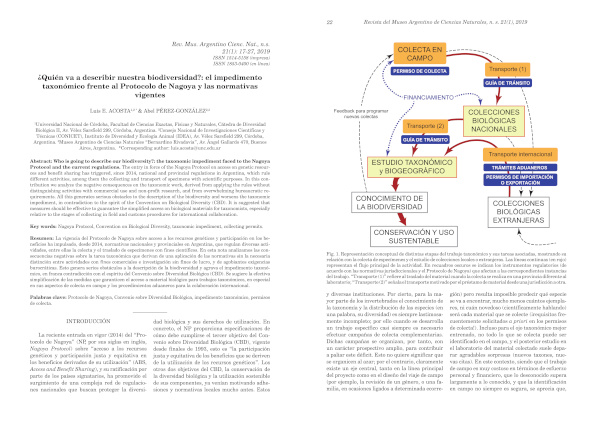¿Quién va a describir nuestra biodiversidad?: el impedimento taxonómico frente al Protocolo de Nagoya y las normativas vigentes
Keywords:
Protocolo de Nagoya, Convenio sobre Diversidad Biológica, impedimento taxonómico, permisos de colectaAbstract
La vigencia del Protocolo de Nagoya sobre acceso a los recursos genéticos y participación en los beneficios ha impulsado, desde 2014, normativas nacionales y provinciales en Argentina, que regulan diversas actividades, entre ellas la colecta y el traslado de especímenes con fines científicos. En esta nota analizamos las consecuencias negativas sobre la tarea taxonómica que derivan de una aplicación de las normativas sin la necesaria distinción entre actividades con fines comerciales e investigación sin fines de lucro, y de agobiantes exigencias burocráticas. Esto genera serios obstáculos a la descripción de la biodiversidad y agrava el impedimento taxonómico, en franca contradicción con el espíritu del Convenio sobre Diversidad Biológica (CBD). Se sugiere la efectiva simplificación de las medidas que garanticen el acceso a material biológico para trabajos taxonómicos, en especial en sus aspectos de colecta en campo y los procedimientos aduaneros para la colaboración internacional.Downloads
References
Acosta, L. E. 1989. Pachyloides hades, nueva especie de opilión de la Argentina (Opiliones, Gonyleptidae, Pachylinae). The Journal of Arachnology 17: 137-142.
Bouchet, P. 1997. Inventorying the molluscan diversity of the world: what is our rate of progress? The Veliger 41(1): 1-11.
Bouchet, P., Bary, S., Héros, V. & Marani, G. 2016. How many species of molluscs are there in the world’s oceans, and who is going to describe them? In: Héros V., Strong E. & Bouchet P. (eds), Tropical Deep-Sea
Benthos, 29: 9-24 (Mémoires du Muséum national d’Histoire naturelle; 208).
Convention on Biological Diversity / Convenio sobre la Diversidad Biológica. https://www.cbd.int/
CBD Technical Series N° 30: Guide to the Global Taxonomy Initiative. pp. i-viii, 1-195. https://www.cbd.int/doc/publications/cbd-ts-30.pdf
Fontaine, B., Perrard, A. & Bouchet, P. 2012. 21 years of shelf life between discovery and description of new species. Current Biology 22(22): R943-944.
Huber, B.A. 2014. Progress and prospects in taxonomy: what is our goal and are we ever going to reach it? The Journal of Arachnology 42: 142–147.
Martens, J. 2016. Das Protokoll von Nagoya und die Folgen für die Biodiversitätsforschung – ein Kommentar. Studia dipterologica, Supplement 21: 8–11.
May, R.M. 2004. Tomorrow’s taxonomy: collecting new species in the field will remain the rate-limiting step. Philosophical Transactions of the Royal Society of London, B 359: 733–734. doi: 10.1098/rstb.2003.1455
Meyer, T. & Weyrauch, W. K. 1966 . Guia para dos excursiones biológicas en la provincia de Tucumán. Miscelánea. Instituto Miguel Lillo, Tucuman, N° 23, pp . 1-127.
Ministerio de Ambiente y Desarrollo Sustentable. Estrategia Nacional sobre la Biodiversidad. Plan de Acción 2016-2020. https://www.argentina.gob.ar/ambiente/biodiversidad/estrategianacional
Mora, C., Tittensor, D.P., Adl, S., Simpson, A.G.B. & Worm, B. 2011. How many species are there on Earth and in the ocean? PLoS Biol 9(8): e1001127. doi: 10.1371/journal.pbio.1001127
Neumann, D., Borisenko, A.V., Coddington, J.A., Häuser, C.L., Butler, C.R., Casino, A., Vogel, J.C., Haszprunar, G. & Giere, P. 2018. Global biodiversity research tied up by juridical interpretations of access and benefit sharing. Organisms Diversity and Evolution 18: 1–12. doi: 10.1007/s13127-017-0347-1
Prathapan, K.D., Pethiyagoda, R., Bawa, K.S., Raven, P.H., Rajan, P.D. and 172 co-signatories from 35 countries. 2018. When the cure kills--CBD limits biodiversity research. Science 360 (6396), 1405-1406. doi: 10.1126/science.aat9844
Silvestri, L.C. 2017. Protocolo de Nagoya: desafíos originados a partir de un texto complejo, ambiguo y controversial. Anuario Mexicano de Derecho Internacional 17: 697-716.
Watanabe, M.E. 2017. The Nagoya Protocol: big steps, new problems. BioScience 67 (4): 400. doi: 10.1093/biosci/bix019
Willink, A. 1999. Biografías zoológicas lilloanas. Revista de la Sociedad Entomológica Argentina 58 (3-4): 3-10.

Downloads
Additional Files
Published
Issue
Section
License
- Authors retain copyright and grant the journal right of first publication with the work simultaneously licensed under aCreative Commons Attribution License that allows others to share the work with an acknowledgement of the work's authorship and initial publication in this journal.
- Authors are permitted and encouraged to post their work online (e.g., in institutional repositories or on their website) as it can lead greater citation of published work.
